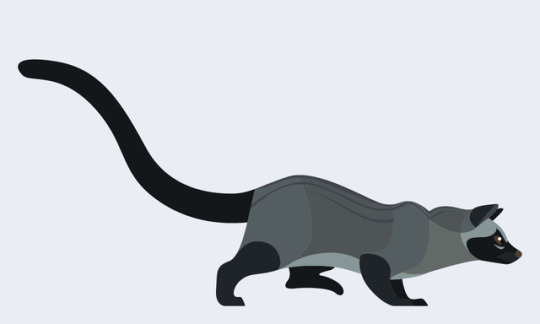#paradoxurus
Explore tagged Tumblr posts
Text

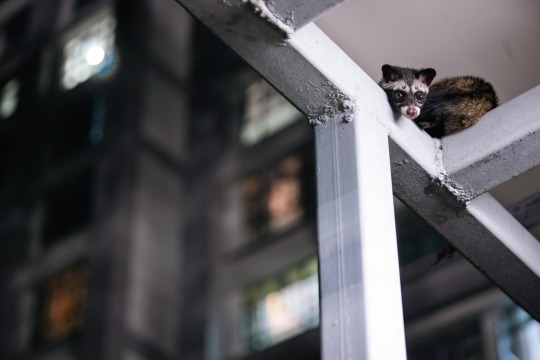
Asian Palm Civet | Tan Yong Lin
#photo#viverridae#paradoxurinae#paradoxurus#paradoxurus hermaphroditus#asian palm civet#tan yong lin
9 notes
·
View notes
Text
Round 3 - Mammalia - Pholidota




(Sources - 1, 2, 3, 4)
Our next mammal order is Pholidota, commonly called “pangolins” or “scaly anteaters.” There is only one living family, Manidae, with three genera: Manis, Phataginus, and Smutsia.
The most distinctive characteristic of pangolins are their large, protective keratin scales, made of the same material as fingernails and toenails, covering their skin. They can curl up into a ball when threatened, with their overlapping scales acting as armor, while they protect their face by tucking it under their tail. This biological armor superficially resembles that of armadillos, though the two are not related. Pangolins can also emit a noxious-smelling chemical from a scent gland, similar to the spray of a skunk, as defense. Their diet consists of mainly ants and termites, as well as other insect larvae, which they capture using their long tongues and sticky saliva. They have short legs, with sharp claws which they use for burrowing into ant and termite mounds, as well as for climbing. They have poor vision, instead relying heavily on smell and hearing. Most pangolins are nocturnal, with the exception of the diurnal Long-tailed Pangolin (Phataginus tetradactyla) (image 3). They are mostly quadrupedal, though some species may walk bipedally occasionally (see gif below). They are also good swimmers and, like armadillos, will fill their stomachs with air before swimming to aid in buoyancy. Terrestrial species dig burrows to live in, while arboreal species live in hollow trees.
Male pangolins are larger than females, weighing up to 40% more. They tend to have larger territories than females, with one males’ territory overlapping that of multiple females. Pangolins are usually solitary animals, meeting only to mate. Males generally mark their location and will wait for females to find him when they are ready to mate. If competition over a female occurs, males can use their tails as clubs to fight for the opportunity to mate with her. A female will produce a litter of one to three offspring, though one pangopup is most common, which they raise for up to two years. The plate-like, keratin scales are soft, white, and rubbery on newborn pangolins, and harden as the animal matures. The mother usually carries her pangopup on her tail, and can fold her baby under her belly if she feels threatened.
The split between pangolins and their closest living relatives, the carnivorans, is estimated to have occurred 79.47 million years ago. Asian and African pangolins are thought to have diverged about 41.37 Ma ago.

Propaganda under the cut:
Pangolins are considered the most trafficked group of animals in the world. Their keratin scales are in high demand in southern China and Vietnam because they are believed to have medicinal properties in traditional Chinese and Vietnamese medicine. These beliefs hold that the ground-up scales can stimulate lactation or cure cancer or asthma. Their meat is also considered a delicacy. Around 100,000 pangolins are estimated to be trafficked a year to China and Vietnam, amounting to over one million over the past decade. All eight species of pangolin are now assessed as threatened by the IUCN, while three are classified as critically endangered.
Early speculation about pangolins being the source of the COVID-19 virus may have led to mass slaughters, endangering them further, which was similar to what happened to Asian Palm Civets (Paradoxurus hermaphroditus) during the SARS outbreak. It was later proven that the testing which suggested that pangolins were a potential host for the virus was flawed, when genetic analysis showed that the spike protein and its binding to receptors in pangolins had minimal effect from the virus, and therefore were not likely mechanisms for COVID-19 infections in humans. Pangolins were also not one of the animals for sale at the Wuhan Huanan Seafood Wholesale Market, the live animal and seafood market that is considered the most likely point of origin for the virus.
Large pangolins can extend their tongues as much as 40 cm (1.3 ft), with a diameter of only about 0.5 cm (1⁄5 in).
A single pangolin can consume 140 to 200 g (5 to 7 oz) of insects per day.
Some long-tailed species, such as the Tree Pangolin (Phataginus tricuspis), use their strong, prehensile tails to hang from tree branches and strip away bark from the trunk, exposing insect nests inside.
The Long-tailed Pangolin (Phataginus tetradactyla) (image 3) is the smallest of the eight living species of pangolins, even with its long tail. Its body can reach a length of 30–40 cm (1–1.3 ft) and weigh 2-2.5 kg (4.4-5.5 lb).
The largest living species of pangolin is the Giant Pangolin (Smutsia gigantea). Male body lengths are between 137-180 cm (4.5-5.9 ft) and females about 112.5-136.5 cm (3.7-4.5 ft). Average mass has not been measured, but one specimen was found to weigh between 30 kg (66 lb) and 40 kg (88 lb). Adult Giant Pangolins can use their weight to simply lean on termite mounds to break them open.
Male Chinese Pangolins (Manis pentadactyla) (image 2) have been observed allowing females with a baby share their burrow.
Most pangolins have not done well in human care, but some zoos have had luck with the Indian Pangolin (Manis crassicaudata). Successful reproduction by Indian Pangolins has been reported in several zoos, including the Oklahoma Zoo and Nandankanan Zoological Park, providing some hope for this endangered species.
Mother Philippine Pangolins (Manis culionensis) sleep rolled into a ball for defense like usual, but with their pup cradled in a ball of their own, encompassed within the mother's ball.
Kadazans use the scales of the Sunda Pangolin (Manis javanica) (image 4) to make special armour to protect their warriors.
86 notes
·
View notes
Text

Island Palm Civet (Paradoxurus philippinensis philippinensis). Belait, Brunei Darussalam. Photo by Chien C. Lee.
30 notes
·
View notes
Text


This animal was requested!
#asian wildlife#asia#feliformia#viverridae#carnivora#mammalia#asian palm civet#animal polls#my polls#poll blog#animals#polls#tumblr polls#wildlife
68 notes
·
View notes
Text

Dharma Giri
Asian palm civet (Paradoxurus hermaphroditus)
TATR, MH India
35 notes
·
View notes
Text
UNLIKELY FASCINATION
PART III: "Forever and Ever"
It was Sunday—the laziest day of the week. Waking up at 9, I strolled past my front balcony, heading straight to the kitchen for breakfast. Then, I opened my computer to work on my project.
The clock struck twelve. As I prepared for a bath, I felt something queer. Did I forget to do something? I wondered while opening the door to the balcony.
"Oops! How could I forget this?" I mumbled.
I placed the bananas on the cupboard behind which the civet stayed.

Yes, it has been quite a few years. It grew older, and I grew up.
I really grew up. Actually, that’s misleading. Nothing much changed about me—I just became mature enough to realize what reality is. I grew from a child eager to make friends, to a teenager traumatized by friendship, to a mature person afraid to make friends.
Have any of you ever experienced living in an environment, studying in a school with your agemates, and realizing that no one—absolutely no one—thinks like you? No one understands your sense of "friendship." No one understands your definition of "loyalty." No one understands your idea of "happiness." At that point, you may feel you are innocent. And yes, I admit I was innocent, and I want to remain unchanged for my entire life.
Sometimes you will be framed. And then you may call yourself a fool, but you are not. You are just not experienced enough to understand who deserves your friendship. Friendship requires trust. Trust demands loyalty, and—
LOYALTY is an EXPENSIVE thing that you cannot expect from CHEAP people.
Hence, now I’m afraid—maybe I won’t be able to distinguish the rich from the cheap. It requires skill to distinguish a diamond from moissanite. It requires even more skill to identify a rich heart from rich apparel.
Hence, now, I am truly petrified—of friendship... with narcissists.
But don’t think I’m devoid of friendship. I do have friends, and I’m genuinely happy with them.
I’m proud to say that I’m an animal lover. I love all animals. To me, they are my best friends. Whenever I see them, I feel an eternal, inseparable bond existing between us—something rare, beyond profit, beyond ulterior motives, beyond any conditions—so natural, so resolute.

As I was placing the civet’s food, it came out, only to stare at me for a few obsessed moments. Earlier, it was introverted—it restrained itself from appearing in front of me, yet secretly watched me. That’s hypocrisy, though. But I loved how it changed. Seeing its change, I asked:
"It has been so many years, and still you haven’t answered me."
It looked at me cluelessly.
"What? Did you ever answer me whether you want to be my friend or not?"
It picked up its food and took a bite.
I smirked and walked away.
At this point, both of us knew the answer to the question. I reminisced about our sweet memories—the time when our eyes first met, that dining table incident which still gives me goosebumps, and how I developed an unlikely fascination for a civet cat, a wild, supposedly nasty species, even though I hated cats.
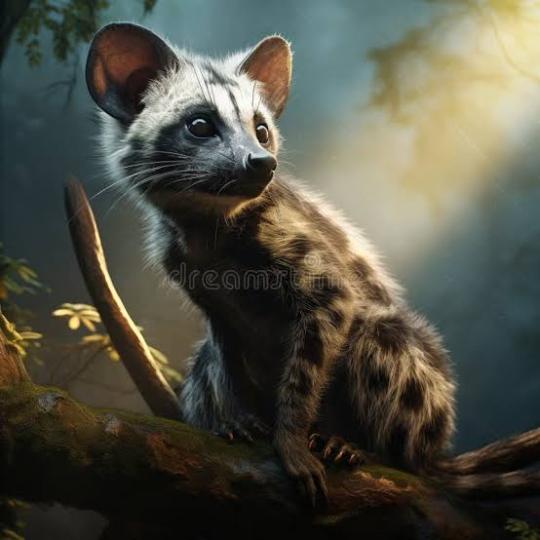
Oh, there’s something I must tell you all. Civet cats are not cats. Yes, the scientific name of the house cat is Felis catus. Thus, all cats are generally part of the Felis genus, although their species may differ, like Felis chaus (Jungle cat) or Felis bieti (Chinese Mountain cat). But civets are not one of them. Civets belong to the family Viverridae, and they don’t form a monophyletic group.
In West Bengal, we generally find Paradoxurus hermaphroditus (Common Palm Civet) or Viverricula indica (Small Indian Civet). And believe me, I found this out on the last day of my Class 10 board exams—coincidentally, the day I studied biology for the final time for exam—since I pursued Physics, Chemistry, Mathematics, and Computer Science as my main subjects in Class 11.
So my fascination wasn’t that unlikely, as it’s really not a cat. I know it may sound melodramatic and cheesy; it may even resemble a mistaken identity plot. It might seem like an attempt to romanticize the idea—love is all perfect and ideal—even though the shape of Earth isn’t—but for God’s sake, believe me, I didn’t make it up for the story. It’s damn true.
Anyway, aren’t you eager to know the answer to the question from earlier? Well, it was—
“Forever and Ever.”

#literature#spilled ink#thoughts#writing#animal love#cats#care#civets#love#inspiring quotes#childhood days#animals#cats of tumblr#original story#original#writers on tumblr#writers and poets#writerscommunity#pets#english literature#passion#prose#spilled poetry#poets on tumblr#cat#childhood#life lessons#life#motivation#friends
20 notes
·
View notes
Text
Uncharismatic Fact of the Day
Asian palm civets are most widely known for their production of coffee beans for Kopi Luwak coffee, but they're also associated with another, equally popular drink: the toddy! The toddy cat also feeds on palm flower sap, which when fermented becomes a sweet liquor known as toddy which gives this cat its name.
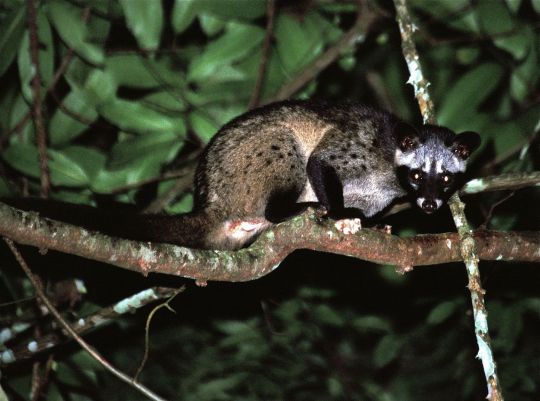
(Image: An Asian palm civet (Paradoxurus hermaphroditus) by Bernard Dupont via Wikimedia Commons)
If you send me proof that you’ve made a donation to UNRWA or another organization benefiting Palestinians, I’ll make art of any animal of your choosing.
63 notes
·
View notes
Quote
ゾウに限らず、動物の糞から採取されたコーヒー豆が今、注目を集めている。ブラジルには、南米原産のカオグロナキシャクケイ(Pipile jacutinga)と呼ばれる絶滅危惧種の鳥の糞から���り出し、洗浄、焙煎したコーヒー豆がある。また、糞ではないが、サルが実を食べた後吐き出した種子を集めて焙煎したものもある。 しかし、「自然に精製」されたコーヒー豆として最もよく知られているのは、パームシベット(Paradoxurus hermaphroditus)という動物の糞から採取された「コピ・ルアク」だ。 孤独を好み足の短いパームシベットはジャコウネコ科ハクビシン亜科の仲間で、東南アジアが原産だ。その糞から採取されたコーヒー豆は、数十年前から存在する。ナショナル ジオグラフィックが初めてこれを報道した��は1981年だったが、その後も反響を呼び続け、需要が拡大した。
1杯1万円にも、ジャコウネコなどの糞で作るコーヒーの「闇」 | ナショナル ジオグラフィック日本版サイト
4 notes
·
View notes
Text
What is Kopi Luwak Coffee and How is It Produced?

Kopi Luwak coffee is one of the rarest and most expensive coffees in the world. This special coffee is produced in Southeast Asia, in regions such as Indonesia, the Philippines and Vietnam. Kopi Luwak takes its name from a mammal known as “luwak” in Indonesian.
The production process is quite interesting. Kopi Luwak coffee is obtained by passing through the digestive system of the palm marten (Paradoxurus hermaphroditus), a free-living animal in nature. After the marten eats the coffee cherries, it excretes the coffee beans that pass through its digestive system in its feces. The beans in this feces are then collected, cleaned and roasted.
0 notes
Text
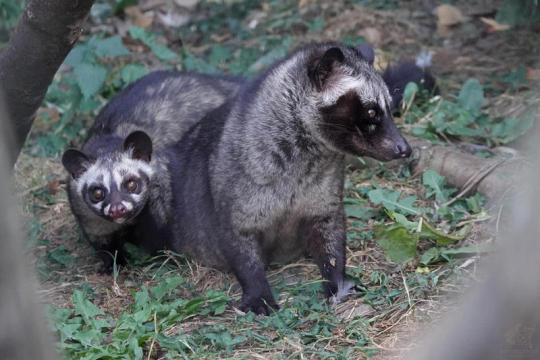
Tell Them Who We ARe
When: August 7, 2022 Where: Faunapark Flakkee Nieuwe-Tonge, the Netherlands
You had to be real sneaky to photograph the babies. If they saw you or heard you (heck, maybe even smelled you) they'd immediately run and hide and stay hidden for half the day. Especially if you held a camera. So we have a lot less photos than we hoped... But those we do have, are extra precious like this one of the mother and one of her 4 babies.
Species: Asian Palm Civet (Loewak, Palmroller of koffierat) Latin name: Paradoxurus Hermaphroditus Originates from Pakistan, India, Southern China and Southeast Asia. Current status: Least Concern
Did you know: … It is probably for its part in the production of Kopi Luwak – a civet coffee that refers to the seeds of coffee berries once they have been eaten and defecated by this animal – that they are best known. … It has been suggested that the increase of capturing Asian Palm Civets to produce Kopi Luwak – aside from being hunted for bush meat and the pet trade – may constitute a significant threat to wild populations. … Unlike similar Civet species, the Asian Palm Civet has a ringless tail. … Their habit of feeding on palm flower sap, which turns into toddy (a sweet liquor) when fermented, has been cause to sometimes name Asian Palm Civets “Toddy Cats”. … Anal scent glands will emit a nauseating secretion as a chemical defense when threatened or upset. … Despite what it’s species name might suggest – Hermaphroditus – the Asian Palm Civets have, like all other mammals, two distinct sexes and are not in fact hermaphrodites.
© Mouselemur Photography • Portegiesje Our work is copyrighted. Do not reproduce, copy edit, publish, transmit or upload in any way without our written permission. Send us a note or chat message if you want to use our work as a reference.
0 notes
Text
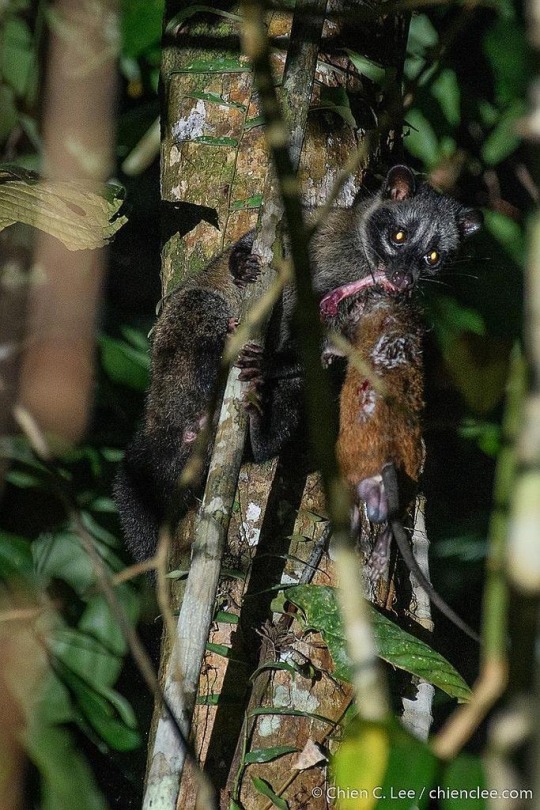
Philippine Palm Civet | Chien C. Lee
#photo#viverridae#paradoxurinae#paradoxurus#paradoxurus philippinensis#philippine palm civet#carcass#chien c lee
10 notes
·
View notes
Text
can confirm! :D
asian palm civets (paradoxurus hermaphroditus) come in all sorts of colors, although brown is most common, and this appears to be one!
the piebaldism gene is a gene that appears in many, many animals (although i've only seen it in chordata animals). said gene removes pigmentation in random patches :)
this does, in fact, appear to be an asian palm civet with piebaldism
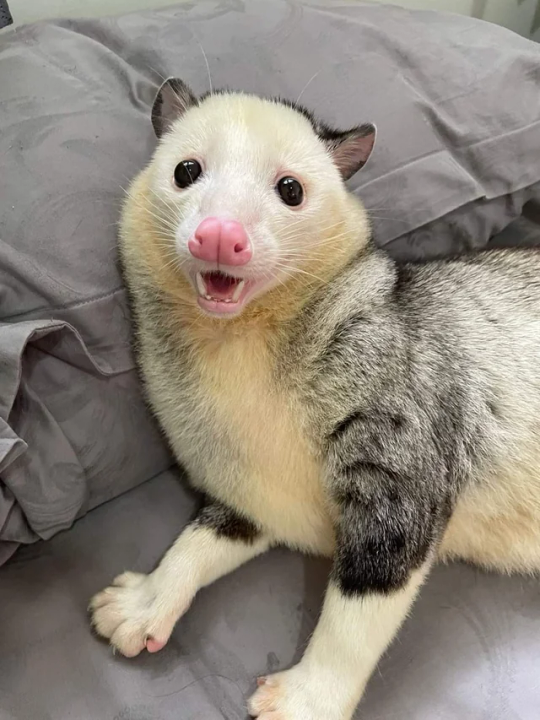
this fucking piebald palm civet (?)
7K notes
·
View notes
Text
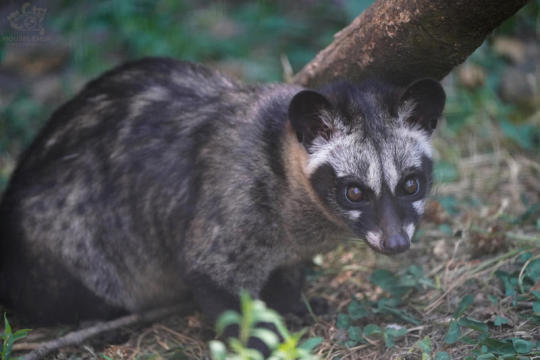
'Cauyse I'm Beginning To Believe
When: August 7, 2022 Where: Faunapark Flakkee Nieuwe-Tonge, the Netherlands
It's crazy how much these youngsters look like mini adults from such a young age.
Species: Asian Palm Civet (Loewak, Palmroller of koffierat) Latin name: Paradoxurus Hermaphroditus Originates from Pakistan, India, Southern China and Southeast Asia. Current status: Least Concern
Did you know: … It is probably for its part in the production of Kopi Luwak – a civet coffee that refers to the seeds of coffee berries once they have been eaten and defecated by this animal – that they are best known. … It has been suggested that the increase of capturing Asian Palm Civets to produce Kopi Luwak – aside from being hunted for bush meat and the pet trade – may constitute a significant threat to wild populations. … Unlike similar Civet species, the Asian Palm Civet has a ringless tail. … Their habit of feeding on palm flower sap, which turns into toddy (a sweet liquor) when fermented, has been cause to sometimes name Asian Palm Civets “Toddy Cats”. … Anal scent glands will emit a nauseating secretion as a chemical defense when threatened or upset. … Despite what it’s species name might suggest – Hermaphroditus – the Asian Palm Civets have, like all other mammals, two distinct sexes and are not in fact hermaphrodites.
© Mouselemur Photography • Portegiesje Our work is copyrighted. Do not reproduce, copy edit, publish, transmit or upload in any way without our written permission. Send us a note or chat message if you want to use our work as a reference.
0 notes
Text
กาแฟขี้ชะมด
กาแฟขี้ชะมด ความลับเบื้องหลังกาแฟแพงที่สุดในโลก
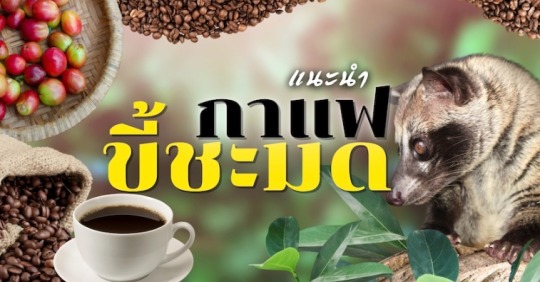
ใครๆ ก็รู้ว่าโกปิลูวัก หรือ กาแฟขี้ชะมด นั้นทำมาจากอึของชะมด ซึ่งเป็นความโชคร้ายของมัน (จริงๆ แล้วโกปิลูวักมาจากอึของอีเห็นข้างลายที่มีชื่อวิทยาศาสตร์ว่า Paradoxurus hermaphroditus หรืออีเห็นธรรมดา อยู่ในวงศ์ชะมดและอีเห็น แต่กาแฟขี้ชะมดเป็นชื่อเรียกที่รู้จักกันในท้องตลาด)
มันเป็นทั้งกาแฟแพงที่สุดในโลกและทำมาจากอึ หรือจะพูดให้ถูกคือทำจากเมล็ดกาแฟที่ถูกย่อยบางส่วนแล้วอึออกมาโดยชะมด สัตว์เลี้ยงลูกด้วยนมคล้ายแมว เท่าที่รู้กัน “โกปิลูกวัก” หนึ่งถ้วยขายในสหรัฐอเมริการาคาราว 2,600 บาท
ชะมดมีหางยาวเหมือนลิง หน้ามีลายคล้ายแร็กคูน บนตัวมีลายยาวหรือลายจุด พบได้ในเอเชียตะวันออกเฉียงใต้และแอฟริกาทางตอนใต้ของทะเลทรายสะฮารา ชะมดมีบทบาทสำคัญในห่วงโซ่อาหารเพราะมันกินแมลงและสัตว์เลื้อยคลานขนาดเล็ก นอกเหนือจากผลไม้อย่างผลกาแฟกับมะม่วง ในขณะเดียวกันมันก็ถูกเสือดาว งูตัวใหญ่ๆ และจระเข้กินด้วย
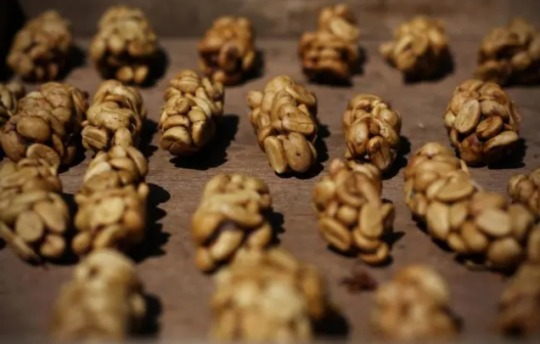
ตอนแรกๆ การค้ากาแฟขี้ชะมดทำท่าจะดีต่อสัตว์อย่างชะมดอยู่เหมือนกัน ในอินโดนีเซีย ชะมด ซึ่งเป็นสัตว์วงศ์เดียวกับอีเห็น มักบุกเข้าไปกินผลไม้ที่ชาวบ้านปลูกเอาไว้ขาย มันจึงถูกมองเป็นศัตรูพืช ดังนั้นการเติบโตของอุตสาหกรรมโกปิลูวัก จึงส่งเสริมให้คนท้องถิ่นปกป้องชะมดเพราะอึของมันมีค่า เอ็นไซม์ย่อยอาหารของชะมดเปลี่ยนโครงสร้างโปรตีนในเมล็ดกาแฟ ซึ่งกำจัดความเป็นกรดบางส่วนออก ทำให้ได้กาแฟรสชาตินุ่มนวลขึ้น
แต่เมื่อกาแฟขี้ชะมดเริ่มโด่งดังไปพร้อมกับที่อินโดนีเซียกลายเป็นจุดหมายปลายทางของนักท่องเที่ยวที่อยากมาเยือนและมีปฏิสัมพันธ์กับสัตว์ป่า ชะมดที่เคยอยู่ป่าก็ถูกจับมาขังในไร่กาแฟมากขึ้นเรื่อยๆ ส่วนหนึ่งเพื่อใช้ในการผลิตกาแฟ อีกส่วนก็เพื่อทำเงินจากนักท่องเที่ยวที่มายืนจ้องพวกมัน
นักวิจัยจากหน่วยวิจัยการอนุรักษ์สัตว์ป่า มหาวิทยาลัยออกซฟอร์ด และองค์กรไม่แสวงหาผลกำไร World Animal Protection ซึ่งมีสำนักงานในลอนดอน ประเมินสภาพความเป็นอยู่ของชะมดป่า 50 ตัวที่ขังอยู่ในกรงที่ไร่กาแฟ 16 แห่งในบาหลี และรายงานผลในวารสาร Animal Welfare ฉายให้เห็นภาพน่าอเนจอนาถ
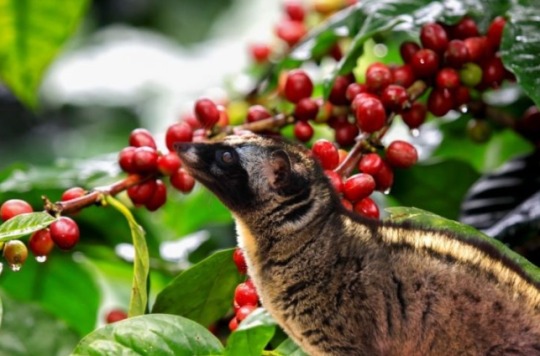
ไร่กาแฟทุกแห่งที่นักวิจัยไปเก็บข้อมูล ไม่มีแห่งใดเลยที่จะใส่ใจสวัสดิภาพของสัตว์ ตั้งแต่ขนาดและความสะอาดของกรง จนถึงความสามารถที่ชะมดจะใช้ชีวิตเยี่��งชะมดปรกติ “บางกรงเล็กมากๆ จนเรียกว่าเป็นกรงกระต่ายก็ได้ แถมยังเปียกชุ่มด้วยฉี่และอึไปทั่ว” นีล ดิครูซ หนึ่งในทีมนักวิจัยกล่าว
ชะมดบางตัวผอมมากเนื่องจากถูกเลี้ยงด้วยอาหารอันจำกัดคือผลกาแฟเท่านั้น สิ่งที่ร่างกายมันได้รับคือผลที่ห่อหุ้มเมล็ดกาแฟ บางตัวก็อ้วนเกินเพราะไม่เคยได้เคลื่อนไหวอย่างเป็นอิสระ บางตัวก็ถูกกระตุ้นด้วยคาเฟอีน ดิครูซเล่า
แต่ที่น่าหดหู่ที่สุดก็คือพื้นกรงที่ทำจากลวดสานกันเป็นตาข่าย บังคับให้ชะมดต้องยืน นั่ง นอนอยู่ตรงนั้นตลอดเวลา “ถ้าหากคุณต้องยืนบนลวดที่สานกันแบบนั้นตลอดเวลา มันจะทำให้คุณเป็นแผลและมีรอยขีดข่วน” ชะมดไม่สามารถหนีพ้นจากพื้นชนิดที่ว่าได้เลย ดิครูซกล่าวว่า “มันสร้างความเจ็บปวดตลอดเวลาและรุนแรง”
ยิ่งไปกว่านั้น ชะมดจำนวนมากไม่มีน้ำสะอาดกินและไม่มีโอกาสจะมีปฏิสัมพันธ์กับชะมดตัวอื่น ชะมดเป็นสัตว์หากินกลางคืน แต่มันต้องอยู่ในที่โล่งตลอดเวลาในเวลากลางวัน และต้องเผชิญกับเสียงดังจากการจราจรและนักท่องเที่ยวอีกด้วย
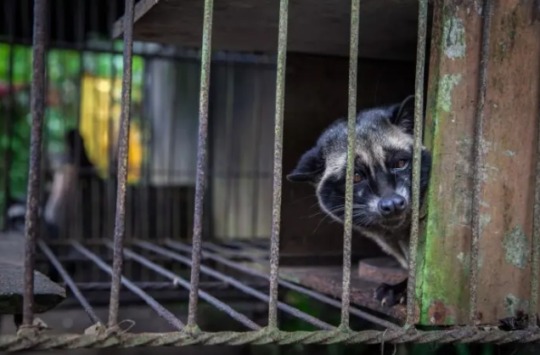
ขี้ชะมดป่าหรือขี้ชะมดกรง ไม่มีใครรู้แน่
ผู้เชี่ยวชาญบอกว่าอย่างหนึ่งที่ทำให้โกปิลูวักพิเศษ ก็เพราะชะมดป่าเลือกผลกาแฟคุณภาพดีกิน เมื่อขังชะมดไว้ในกรงแล้วเลี้ยงมันแต่ผลกาแฟเก่าๆ ผลที่ได้ก็จะมีคุณภาพต่ำไปด้วย นอกจากนี้ ผู้เชี่ยวชาญด้านกาแฟคนหนึ่งเคยกล่าวไว้ในบทความของ Specialty Coffee Association of America องค์การการค้ากาแฟของผู้คั่วกาแฟกรูเมต์และบาริสตา��่า โกปิลูกวัก ไม่ได้ดีอย่างที่ว่ากัน ถึงแม้ว่ากระบวนการย่อยอาหารของชะมดจะทำให้กาแฟนุ่มนวลขึ้น แต่มันก็ทำลายกรดและกลิ่นที่บอกลักษณะกาแฟชั้นดีออกไปด้วย
ปัจจุบันไม่มีใครบอกได้ว่ากาแฟโกปิลูวักถุงใดที่มาจากชะมดป่าหรือชะมดกรง เมื่อปี 2013 บีบีซีเคยเปิดโปงความไร้มนุษยธรรมในการผลิตกาแฟจากชะมดในกรงขัง จนยุโรปต้องออกกฎติดฉลากกาแฟที่มาจากชะมดป่า แม้แต่ผู้ค้ากาแฟอย่าง โทนี ไวลด์ ซึ่งแนะนำโกปิลูวักให้ชาวตะวันตกได้รู้จัก ก็ต่อต้านเรื่องนี้ในบทความที่ตีพิมพ์ใน Guardian เขากล่าวว่ามันกลายเป็นอุตสาหกรรม ทารุณ และจอมปลอม อย่างไรก็ตาม ไม่มีการรับรองใดๆ ที่จะทำให้ผู้ซื้อมั่นใจได้ว่ากาแฟที่ติดฉลากขี้ชะมด “ป่า” จะเชื่อถือได้ และผู้รับรองกาแฟที่กำลังทำงานเพื่อให้ผู้ผลิตรับผิดชอบต่อสิ่งแวดล้อมก็ปฏิเสธจะออกใบรับรองกับกาแฟขี้ชะมดยี่ห้อใดๆ ตามมาตรฐานเครือข่ายเกษตรกรรมยั่งยืน (Sustainable Agriculture Network-SAN) ของพันธมิตรป่าฝนและผู้รับรองอื่นๆ ที่มีชื่อเสียงซึ่งใช้ในการออกตราประทับรับรองห้ามการล่าและจับสัตว์ป่าในการทำเกษตร การห้ามชะมดกรงเป็นแนวทางที่ถูกพูดถึงเป็นพิเศษในกรณีของกาแฟจากอินโดนีเซีย ส่วนมาตรฐานการรับรองกาแฟยั่งยืน UTZ ก็ห้ามขังสัตว์ป่าเพื่อการเกษตรเช่นกันและไม่รับรองโกปิลูวักใดๆ ทั้งสิ้น
อเล็กซ์ มอร์แกน จากพันธมิตรป่าฝนซึ่งใช้มาตรฐาน SAN ระบุว่ามันเสี่ยงเกินไปที่จะรับรองโกปิลูวัก เพราะมันยากมากที่จะรับรองว่าเมล็ดกาแฟมาจากธรรมชาติร้อยเปอร์เซนต์หรือไม่ “ความเห็นส่วนตัวของผมคือจงหลีกเลี่ยงมัน” มอร์แกนกล่าว “ส่วนใหญ่มันมักจะมากจากถิ่นที่ผลิตกาแฟด้วยการขังชะมดทั้งนั้น”
หวยหุ้นดาวโจนส์
0 notes
Text
Historia paru łasz - cz. I
Dodano: 2007-12-13 20:27:14
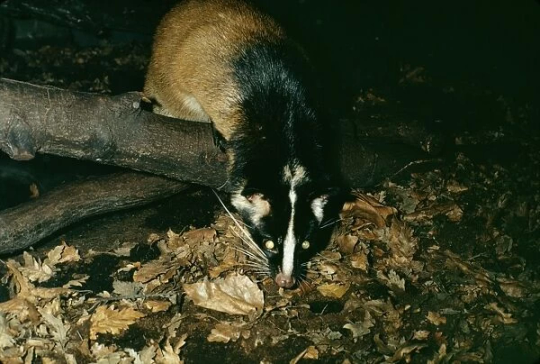
Ziemia jest mieszkaniem masy rzadkich ssaków. Szczególnym mistycznym zagadnieniem otacza się pewną rodzinę ssaków drapieżnych - zwiemy je tajemniczymi łaszami. Są to zwierzęta niespotykanie ciche i niepospolicie niezwykłe. W systematyce zoologicznej podzielone je na trzy rodziny. Żyje wśród nich pewien rybożer, zwierz nader skromny i nieprzenikliwy. W lasach to wybitnie nocne ziemnowodne zwierzę (a może aktywny jest także w dzień?) czatuje na swoje ofiary. Nie tylko nigdy nie nakręcono o nim filmu, ale i także nie wiadomo czy już nie wymarł. Zamieszkuje on dorzecze północnowschodniego Zairu, nie w Kongo jak niektórzy podają. Wyposażony w błony pławne i długi czarny ogon czatuje na ryby i wodne bezkręgowce. Ma krótkie nogi przednie i lisi pysk. To łasza z grupy wiwer. Nie wiadomo nic o jej zachowaniu, rozrodzie i trybie życia. W lasach Afryki żyje także łasza palmowa, ssak z rodziny Nandiniidae. Na Madagaskarze żyją fossy, fanaloki i falanruki. Tam też wspomina się o innych nieznanych łaszach na dla nauki - bokyboky. Viverridae to carnivory starego świata, nie występują w obu Amerykach. Największa ich radiacja grup rodzajowych zaistniała jednak w Azji Południowo-wschodniej. Tu żyje łaskun muzang, który wytwarza jedyne na świecie specyficzne produkty do najdroższej kawy świata - kopi luwak. Ale są jeszcze inne łasze, jeszcze bardziej tajemnicze i mniej poznane.
Paradoxurus hermaphroditus
Nie wiem czy wolno tu mi o nich mówić. Wiele z nich przyprawia o ból głowy i działa na neurony. Istnieje kunołaz laotański Owstona o długiej czaszce z pręgami na ciele. To zwierzę prowadzi naziemny tryb życia, gdzie żywi się dzdżownicami. Wydziela on jednak bardzo silny zapach z gruczołów okołodbytowych odstraszający wrogów. Do jego krewnych należy kunołaz pręgowany Hemigalus derbyanus z żółtymi, hipnotyzującymi ślepiami. On też ma wydłużoną czaszkę, przez twarz od potylicy, aż do płytki nosowej ciągnie się czarna pręga. Zwierz przyjmuje kremową sierść pokrytą pasami brązowej sierści. Wśród cywet z rodzaju Viverra, istnieją wspaniale barwne gatunki, wśród nich wiele pojawiło się w nauce jako okazy typowe. Jest też pewne grono tych ssaków, bez wyglądu. są to ssaki, o których nie wiemy jak wyglądają. O nich jednak nie powiem, tak prawdziwie to niezwykłe gatunki, że zahaczają o kryptozoologię. Wśród zakonspirowanych gatunków jest żeneta królewska znana jedynie z 10 okazów. Od wielu lat się o niej nie mówi, toż też może być już wymarła. W planach przeglądu tych drapieżników natrafiamy na wielkogłowego łaskuna brązowego z Sulawesi - o sylwetce kota. Fossa drapieżna na Madagaskarze, przyjmuje formę niszową dużych kotów, których nie ma w tej częsci śwaita. Żyje na drzewach i wykonuje dalekie skoki z jednej gałęzi na gałąz. W lasach Azji żyją niedźwiedziopodobny granatowy binturong drzewny z pędzelkami na uszach, kunołaz czarnobiały Diplogale hosei - ten który miał być kotolisem z Borneo. Jego to nie widziano od ponad 50 lat. Ba, nigdy go ponoć na żywo nie widział żaden biały.
Nandinia binotata
Trzy lata temu zrobio mu pierwsze zdjęcia, aparatem superświatłoczułym na ruch i temperaturę. W odludnych lasach Palni, Nilgiri i Anamalai hills, Travancore oraz Coorg w Ghatach Zachodnich żyje łaskun Jerdona (krewny łaskuna muzanga) podobny do łaskuna złotego, endemiczny ssak, zwierzę, które nie rozumie wiary w śmierć i zmartwychwstanie. Żywiąc się owadami, ptakami i gryzoniami upodobał sobie zaciszne miejsca, czyhając tylko na swe ofiary. Czy i w innych lasach kroją sobie myśli ich ofiary a z nimi inne jeszcze gatunki, które nie czują pociągu do czegoś z tego świata?
Opracował: Caniche
0 notes
